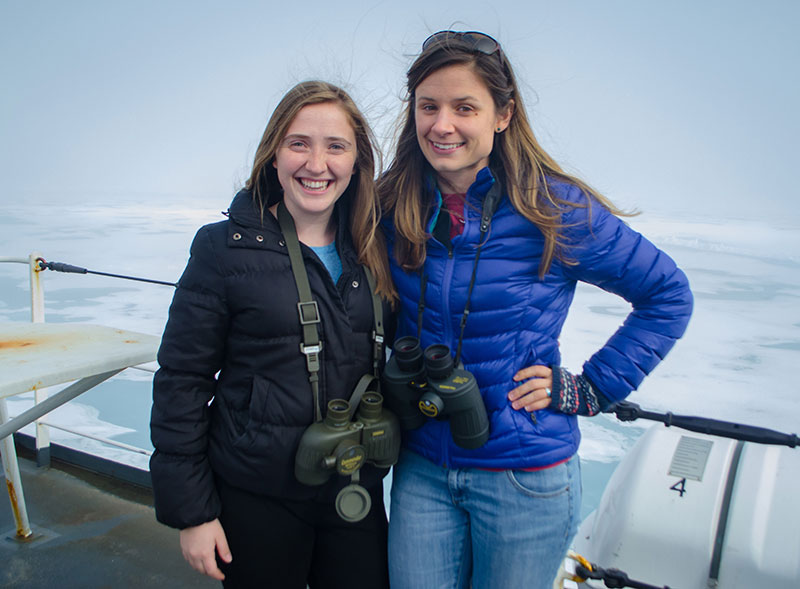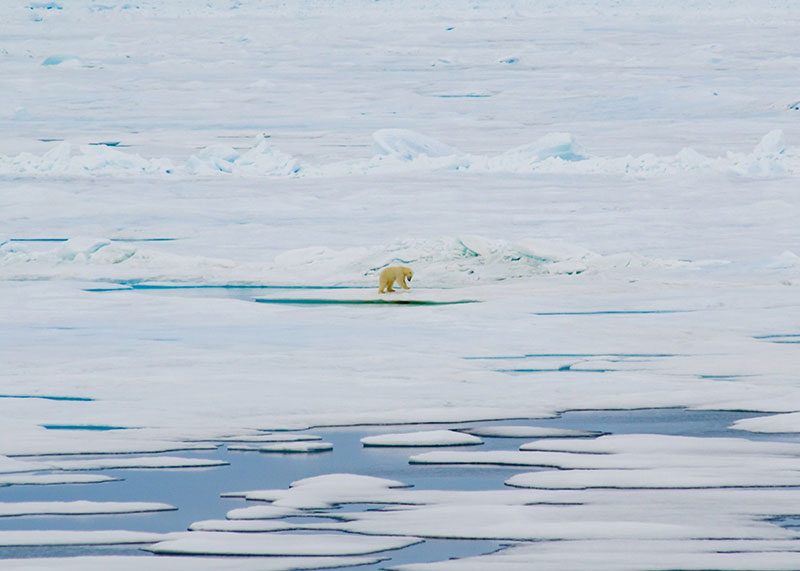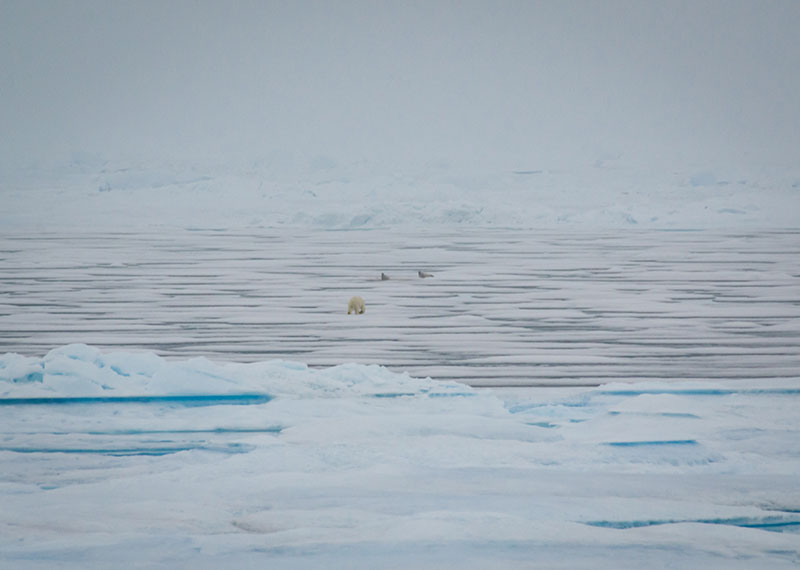
By Erica Escajeda and Jennifer Stern, Graduate Students, University of Washington
July 21, 2016

A polar bear stands on its hind legs to get a better look at the U.S. Coast Guard Cutter Healy. Image courtesy of Jennifer Stern, UW, The Hidden Ocean 2016: Chukchi Borderlands. Download larger version (868 KB).
Polar bear research is a team effort – there are the lucky few who get to go out and work with the bears directly, but there are far more researchers who work on polar bear data and never have the opportunity to see them in the wild. Polar bear research comes in a variety of formats – tracking studies, capture-recapture programs, modeling, physiological studies using samples from captured or harvested animals, and many more. All are equally important and are vital contributions to our growing understanding of these top predators.
We, Jenny Stern and Erica Escajeda, are part of the marine mammal observation team (read more about our survey efforts here). We are graduate students at the University of Washington’s School of Aquatic and Fishery Sciences working under Dr. Kristin Laidre and are currently involved in polar bear research. Erica completed her master’s degree on polar bears and has begun a Ph.D. on marine mammal acoustics. Jenny will begin her master’s studies on polar bear diet in Fall 2016. Below are our perspectives on seeing our study animal in its natural habitat.

Jennifer Stern and Erica Escajeda study polar bears and both have now seen their study animal in the Arctic. Image courtesy of Caitlin Bailey, GFOE, The Hidden Ocean 2016: Chukchi Borderlands. Download larger version (2.2 MB).
JS: Despite growing up in the middle of the country, I have wanted to come to the Arctic since the fifth grade. The extreme nature of the Arctic ecosystem captured my broad scientific interests, more specifically trying to understand what is required for animals to survive an extreme environment. After finishing my undergraduate degree at the University of Kansas, I entered a graduate program at the University of Washington to explore the foraging, or feeding, behavior of polar bears.
My project uses the chemistry of polar bear hair and fat samples as insight into the different components of their diet. Analyzing the samples requires primarily lab work rather than time spent in the field. Thus, having the opportunity to observe polar bears (and their prey) in their natural habitat first-hand is powerful and provides me with a new perspective on my research. During one sighting, we saw the polar bear pounding on a seal den, hoping to find food.
This expedition has created the context for my upcoming master’s project by exposing me to not only my study animal, but also to other parts of the ecosystem that support my study animal.
As we have moved farther north, the availability of food for the bears has changed as well as the ice cover. Observing this ecosystem prior to beginning my master’s degree gives me a more cohesive and broad perspective as I progress through my coursework and lab results.

This polar bear was pounding on a seal den, hoping to find food in the open Arctic landscape. Image courtesy of Caitlin Bailey, GFOE, The Hidden Ocean 2016: Chukchi Borderlands. Download larger version (2.1 MB).

Approaching from a distance, this polar bear attempted to ambush a pair of ribbon seals, which quickly slipped into the water when the bear got too close. Image courtesy of Caitlin Bailey, GFOE, The Hidden Ocean 2016: Chukchi Borderlands. Download larger version (2.1 MB).
EE: I feel very lucky to have spent three years studying polar bears for my master’s research. Studying an animal that inhabits a remote environment such as the Arctic is challenging, however, every year we learn more about polar bear biology and behavior from remote monitoring methods such as satellite telemetry.
For my master’s thesis, I used satellite telemetry data to track the movement of collared pregnant females to and from their maternity dens where they give birth to their cubs. To prepare my master’s thesis, I read as many papers and watched as many polar bear documentaries as I could. While I felt like I knew a great deal about these animals, I had yet to see them in the wild and in their element.
Now that I’ve seen not one but three bears on the sea ice, I have realized that there is something magical about seeing your study subject in the field. All those documentary scenes and papers came to life before my eyes as I watched the bears doing what they did best, being a polar bear.
Seeing the sea ice habitat has also been incredibly inspiring. These bears live solitary lives and are surrounded by miles of open water punctuated by ice floes that allow them to survive in the marine habitat of the Arctic. Seeing the Arctic first hand has sparked more questions and has motivated me to continue learning about this wild and intriguing ecosystem.